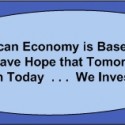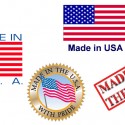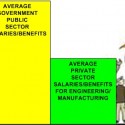The Problem
Before we discuss the problem, let’s first discuss the segment and the value of this segment to Americans and the rest of the world.
Engineering & High Tech Manufacturing Segment
- Known for high speed innovation, technology, technology developers, and for being leading edge.
- Segment feeds large manufacturing and distribution via acquisition, mergers and licensing.
- Segment creates jobs, lots of jobs, for: engineers, scientists, technicians, craftsmen, etc.
- Consistently delivers Message of Hope … that tomorrow will be better than today, hope for new technologies to improve products and improve our life.
In the good ole days before the recession, when the world seemed fairer, here’s an example of a capital equipment manufacturer. In this example, Nova Co is an American high tech manufacturer, and Comp A and Comp B are competitors located in America or Europe. Each of the companies make quality products, and their respective products differ by technology and features.
| Nova Co | Comp A | Comp B | Comp D | Comp F |
|---|---|---|---|---|
| $75,000 | $85,000 | $70,000 | $90,000 | $73,000 |
During the recession several things started to happen. First, the American manufacturers that did not manufacture quality products failed and were the first manufacturers to go out of business. Soon after another interesting phenomena began to surface. Americans fell into either of two mindsets. Either they had hope that tomorrow would be better, or they didn’t have hope. Our American Economy has always been based on Hope. When we have Hope that Tomorrow will be Better than Today, We invest and grow. For example, you may own a cell phone that works fine and you may be able to do just about anything you want with it. If you have Hope that tomorrow will be better, you may decide to buy a new cell phone. With Hope that tomorrow will be better, Americans will buy things. Without Hope, Americans will fix things or do without, or buy cheap over quality.
So, during the recession, our example evolved as follows:
| Nova Co | Comp A | Comp B | Comp C |
|---|---|---|---|
| $59,990 | $80,000 | $65,000 | $22,000 |
| —– Quality Products —– | — Junk — | ||
| Supported Products, Lasts Forever | No Support, Lasts 1-3 years | ||
| Purchased by Companies with Hope that Tomorrow will be Better | Purchased by Companies without Hope
|
||
To offset the effects of a recession, Nova Co and Competitor A and B lowered their selling prices which means that profits were reduced to encourage customers to buy during the recession. Competitor C (for “China) is a new supplier of a similar product. The Chinese are not known for technology, they are known for providing low tech or products based on older technologies. In this example, Comp C offers a cheap knock-off of an old version of equipment to compete with Nova Co, Comp A and Comp B. Lots of American companies bought Comp C because all these same companies were without Hope that tomorrow will be better.
Why is it that American companies don’t have Hope for a Better Tomorrow? In my opinion, the most important job of an American president, or, for that matter, any leader, is to instill hope in the people. During the recession, America’s president had shown his inexperience as a leader, and didn’t fulfill his job of instilling hope for a better tomorrow. As the recession deepened, President Obama began to talk of “hope” by promising Americans that each American that desires to work should have a job that pays well. Unfortunately, it was only “lip” service, since the infrastructure to create a better tomorrow isn’t even on the “drawing board.”
So, without Hope of a Better Tomorrow, American companies preserved capital by laying off tens of thousands of jobs, and companies that needed equipment or capital equipment bought low quality products manufactured in China and Asia but not made in the United States by Americans.
The president foolishly bailed out the financial institutions without ever thinking that the money handed out to the financial institutions would stay with the financial institutions. Which meant that there was no loans available to businesses . Without loans, and without hope, the likelihood of more jobs is dismal.
After awhile, our president seems to have figured out that bailing out insurance and banks just resulted in greed. Next he spent time trying to push his Obama Health Bill. Even more of a joke … still not addressing the underlying problem. Hopefully by the end of his term, he’ll figure out what America needs to prevail.
In any case, I’ve digressed, back to NovaEconomics. Without assistance, is it possible for American high tech engineering and manufacturing companies to compete with China. More specifically, without Hope, the answer is an emphatic NO. Here’s why. We continue with our example and show Nova Co competes with Competitor C.
| Costs to Build One Machine | Nova Co | Comp C |
|---|---|---|
| Costs: Metal, Elect, Welding, Paint, Controllers, Pneumatics, Hardware | $22,000 | $7,000 with Government Subsidies |
| Labor & Burdened Taxes | $21,000 | $2,000 |
| Employee Benefits | — (thankfully Americans can still opt out) | — |
| Overhead: Phone, Electricity, Rent, Marketing | $9,500 | $500 with Government Subsidies |
| Commissions | $3,000 (5%) | $2,200 (10%) |
| Amortized Cost of Technology/Patents | $1,500 | — |
| Profits | $2,990 | $10,300 |
| Profits as Percentage | 5% | 47% |
As the note says, “thankfully” American manufacturers can still opt out of paying health and other benefits to employees. If Obama Health ever became mandatory, American manufacturing is history.
By the way, the only companies that are currently purchasing Nova Co’s products are companies that have Hope for a Better Tomorrow. And thanks to our president and our political system, leadership still hasn’t instilled HOPE and without it and other incentives, the future of American technology and manufacturing is dismal.
What does that mean? Consider the following realizations …
Chinese government continues to subsidize Chinese manufacturing while US government does absolutely nothing to help American manufacturing.
Future of US Military. As Americans we’ve always had confidence that our military is strong, and our equipment is the best. Imagine if US Airforce Fighter Planes were manufactured by China, and we deployed defective Chinese bombs … how will that compromise our confidence?
Did you know that legal accountability is limited to American companies that manufacture products in the United States.
Or what if aspirin and other daily consumed pharmaceutical products were manufactured by the Chinese. Defective aspirin kills how many Americans …
Just telling people that it is important to buy products made in the USA should be good enough, but it’s not. I tried. For my Nova company, I always emphasize that all of our products are designed and manufactured in the United States, and, fortunately, companies with Hope that tomorrow is better will usually buy American.
However, if our government really cares that products are Made in USA, then there needs to be some financial incentives.
- Buy American Instant Credit program. I tried this type of program at Nova and it worked until a customer wanted to apply the Instant Credit to something we don’t sell. Ideally this program would be funded by the manufacturer and marketed by the Government.
- Import Tariffs for Countries where balance of trade is not established or not working. For example, we buy technology from them although they don’t buy technology from us. A good example is China. Actually not sure they buy anything from us. Collected tariffs go to our Government and, as a result, increase the cost of an import over something Made in USA.
- Remove Limits from Investment Tax Credits. Currently there is a limit of $500,000. If our economy is suffering, why is there a limit? Why limit investments into the United States?
- Allow Investment Tax Credits to Carry Forward. Why only allow losses to carry forward?
Unfortunately, it is my opinion that any additional incentives for Made in USA would probably be misused by greed inspired entrepreneurs looking to take advantage of a swing back to Made in USA. One thing the recession successfully accomplished was to get rid of US manufacturers that produced poor quality products. The US-based model of producing low quality products doomed to a scheduled obsolescence became the economic model basis for Chinese manufactured products. And Washington actually prefers the shift of poor quality products manufactured in China for a number of reasons, among them is legal accountability. If a Chinese manufactured product kills or maims, you can’t sue! I’ve always found it odd that a company executive without Hope for a Better Tomorrow is more likely to purchase a Chinese manufactured product for their business, although would not purchase a Chinese manufactured automobile for a family member. Why is it that a company executive’s faith in his/her company’s well being so much less?
Years ago, before the recession, salaries kept increasing. Colleges would promise graduates larger and larger salaries. Government employees received less money than non government employees, and times seemed good.
When the recession started, lack of business resulted in significant layoffs, and the highest paid employees began to migrate from non government to government jobs. Today, government and public utility salaries are far greater than private sector non government jobs.
| 5 Years Ago | Government & Public Sector | Small Mfgr, Private Sector |
|---|---|---|
| Engineers | $60,000 | $80,000 |
| Technicians | $50,000 | $60,000 |
| Craftsmen | $40,000 | $50,000 |
| Today | Government & Public Sector | Small Mfgr, Private Sector |
|---|---|---|
| Engineers | $62,000 | $40-50,000 |
| Technicians | $52,000 | $35-45,000 |
| Craftsmen | $42,000 | $30-40,000 |
At a recent conference attended by several politicians, a concern was discussed relative to the future of Engineers, Technicians and Craftsmen, and the answer was shocking. Several political leaders stated that US manufacturers need to realize that manufacturing in the US will decrease year after year; and that existing employees who have chosen professions including engineers, technicians and craftsmen will have three choices:
a) Retrain. One of the leaders actually said that if an engineer is smart enough the engineer should retrain for something else. With a decreased need for manufacturing, US won’t need engineers in the future;
b) Move to China. This same political leader suggested that since manufacturing is moving to China, that engineers, technicians and crafts people that desire to remain in their field should move to China; and
c) Collect Unemployment Compensation. Again this politician went on to say that if the engineer, technician or crafts person doesn’t want to retrain, or fields too old to retrain, or doesn’t want to move to China, then he suggested they collect unemployment compensation. He went on further to say, that under our current administration, unemployment will never run out.
… and that’s from a political leader. Believe it or not this guy’s affiliation was republican. Like I said, neither party seems to understand the problem, and since politicians are rarely, if ever, from the manufacturing sector, or would consider themselves an engineer, technician or craftsman, it is not that difficult to believe.
Normalize Salaries
So what does salary normalization mean. For manufacturing to exist in the US, government and public sector employees salaries need to be reduced and become more inline with normalized private sector salaries. If for no other reason, how can America afford to pay government and public sector employees so much money when the tax base continues to dwindle. Two years ago, one of my best employees, an individual we were paying $60,000 per year was given an offer to leave Nova Co and work for Florida Power & Electric for a salary in excess of $175,000! And for FPL to pay that kind of salary, rates for electricity have since increased throughout Florida. I hope you agree that there is something significantly off balance.
And benefits. Can you guess which type of employee, one working for the government/public sector or private sector receives the best benefits? Then to top it off, who do you think pays for government employee benefits?
Limit Unemployment Compensation Terms.
Qualified employees remain unemployed waiting for high paying salaries. When President Obama said that every person desiring to work should have a job and be paid well, do you think he implied that those unemployed should stay unemployed until the private sector can afford to pay them what they were making before they lost their job? In Florida there are many engineering/manufacturing jobs available that pay realistic salaries, however the number of candidates available to fill these jobs is at an all-time low. As an employer, we compete with unemployment compensation all the time. Apparently many qualified workers would rather collect $1,200 per month plus part-time income rather than accept a job paying less than they were paid years ago. If there were term limits on unemployment compensation, (a) more people would have jobs, and (b) unemployment costs (and rates) would decrease.
Jury Duty Reform
Why force managerial staff of a small manufacturer to serve when serving could and most often will hurt or potentially result in closing a business? If there is not enough qualified jurors, then bring back seniors and/or others currently excluded from serving. For that matter, why not require unemployed workers collecting Unemployment Insurance Compensation to serve at least one week of jury duty.
Senior Citizen Involvement
Our Senior Citizen population includes some of our Country’s best resources. When these people retire and leave the workforce, we lose so much intellectual property, experience and know how. And during a time when there is so much uncertainty in our current economic condition, why aren’t we relying more on this experienced talent?
Cost Incentives for Employing Seniors
For seniors who desire to stay connected to the workforce, why do employers need to pay social security taxes for seniors in the workforce. There is no additional benefit paid to Senior Citizens once they begin to collect retirement income. So why should their income be reduced by social security taxes. Without paying these additional taxes, seniors could provide valuable services to the workforce at reduced pay rates.
Senior Volunteer Corps
Change S.C.O.R.E. from the current extortion-based employment agency program to a resource of seniors providing valuable services to businesses. And, don’t limit it to assisting management, have seniors help at all levels. Their experience is invaluable, and keeping active is key for continued mental and physical health.
Senior PayRate/Incentives
In lieu of high salaries, seniors helping the workforce could receive travel incentives. For example, seniors could work for a few months, then take time off to travel. Perhaps compensation packages could be based more on travel points than traditional monetary compensation. In other words, how can we increase senior involvement in our workplace during a time when we sure need the help, and at the same time find ways to properly compensate by finding creative incentives.
I have had the fortune to have hired two seniors. Pete and Al. Al was an accomplished machinist and retired from AT&T after working with AT&T for over 30 years. His experience was invaluable. Al came to work for about 20 hours per week. Not only did he share and help train our staff on how to be machinists, he also tackled some of our most difficult to machine parts. Pete worked for us for several years after a long career at Sandia Labs. He then retired and began a lifelong dream of sailing ‘around the world.’ Then one day, by what seems like the grace of G-d, Pete came back to work. However this time he didn’t want to be paid, he did want to share with us his extensive experience as a designer and technician. His contributions were invaluable in my company’s reorganization and focus on the future. Together we designed and built a new product line which remains a success today.
Both Pete and Al were craftsmen in the truest sense of the meaning of workmanship and provided such an invaluable service. They were doers, not just people who thought about doing. They made a difference. Imagine how strong America can become again if American companies can rely on people like Pete and Al. G-d bless senior involvement and G-d bless America!
Representation
America’s business sector is based on the entrepreneur. High tech engineering/manufacturing companies form the basis of innovation for tomorrow’s technologies. I think it is odd that these companies do not have a voice. Our Country favors large manufacturers because there seems to be a myth that large manufacturers represent the largest sector of new job formation. That’s incorrect. Without new technologies and new products developed by entrepreneurial companies, large manufacturers can’t exist, or if they exist, they do so only for a short time.
So, where is the voice of the small high tech engineering/manufacturing company? News Flash … there is no voice. There is no representation. How can our Country continue to be a leader when our political leaders don’t have a clue what obstacles face growth of high tech manufacturing & innovation in the United States.
FYI … Chambers of Commerce represent service sector business. Only a few Chambers will even consider high tech engineering/manufacturing companies, especially the entrepreneurial ones. For example, the Boca Raton Chamber of Commerce (Florida) openly discourages high tech manufacturing members because most entrepreneurial high tech engineering/manufacturing companies hire lower income employees which increases traffic from lower income regions.
Doesn’t seem fair … when will high tech engineering/manufacturing companies have representation. How can political leaders truly learn what obstacles face this important sector of our economy?
How often have you heard … if you need production funding, go to a bank? Well, banks and entrepreneurs just don’t work. Banks look for steady growth, and entrepreneurs by definition either grow explosively or die, but steady growth isn’t entrepreneurial. So, where does an entrepreneurial high tech engineering/manufacturer go for funding? Pretty much limited to venture capital. And where do you think venture capitalists go when the economy isn’t good? If you can tell me where they hide, let me know!
One of the most basic obstacles facing high tech engineering/manufacturing US-based companies is lack of capital. I think the feds know that, however their answer shows just how little they know about this business sector. Our government set up an agency called the Small Business Administration (SBA). And guess how this agency doles out money? Through Banks! The SBA claims they are understaffed and as a result depends on the qualification and eligibility programs instituted by local banks to qualify an entrepreneurial company for an SBA loan. Another government system that is broke!
It would be great if our government can figure out a way to directly fund small entrepreneurial high tech engineering/manufacturing companies without depending on banks. Interesting note, one Florida based bank requires a minimum of 3 years exponential growth before even considering a loan application, and by the way, that loan would be with a personal guarantee by the owner or owners of the company. According to the banker, the only companies they have even considered were legal/attorney firms. There’s an example of a service sector business that does well regardless of the economy!






